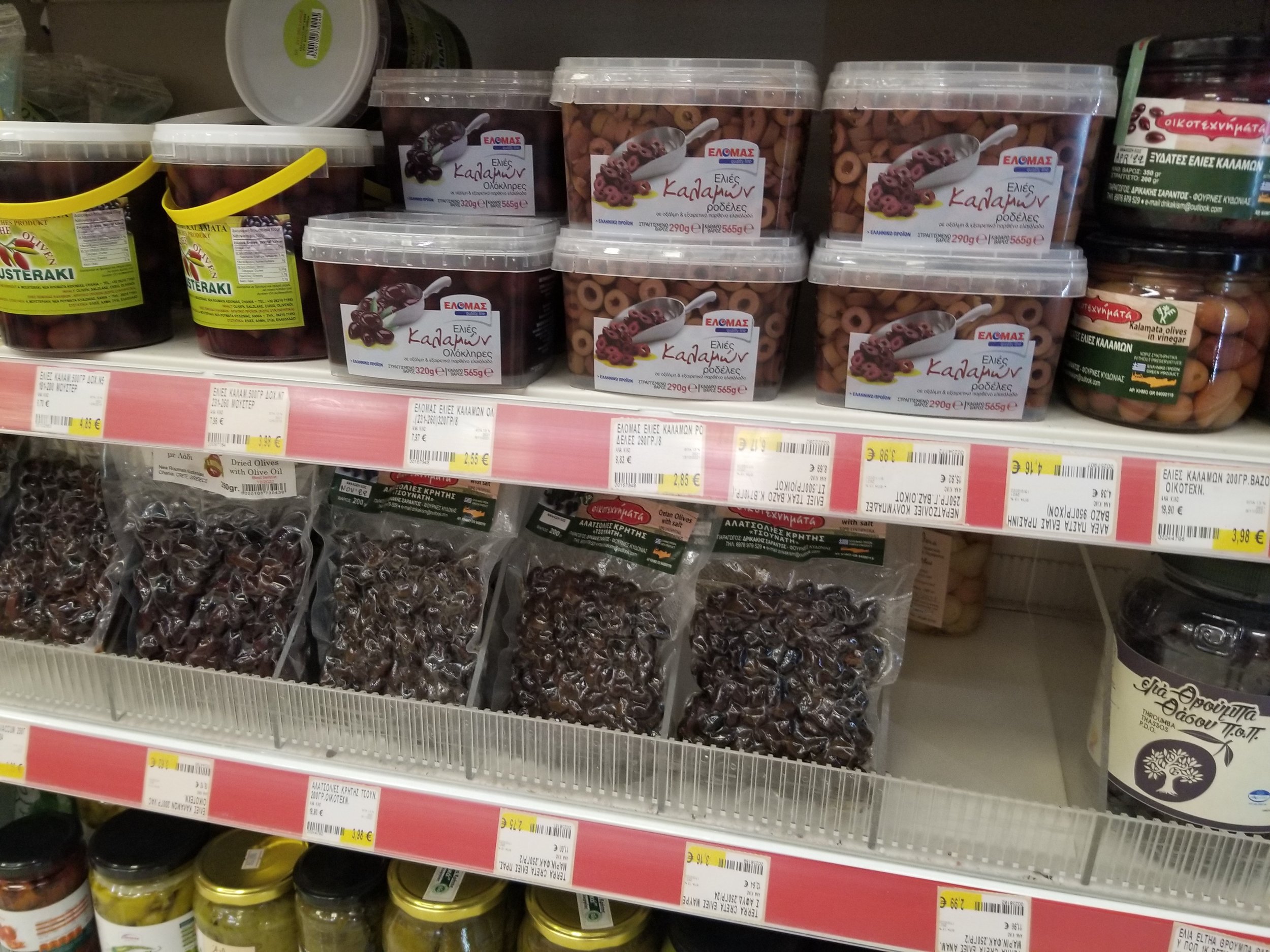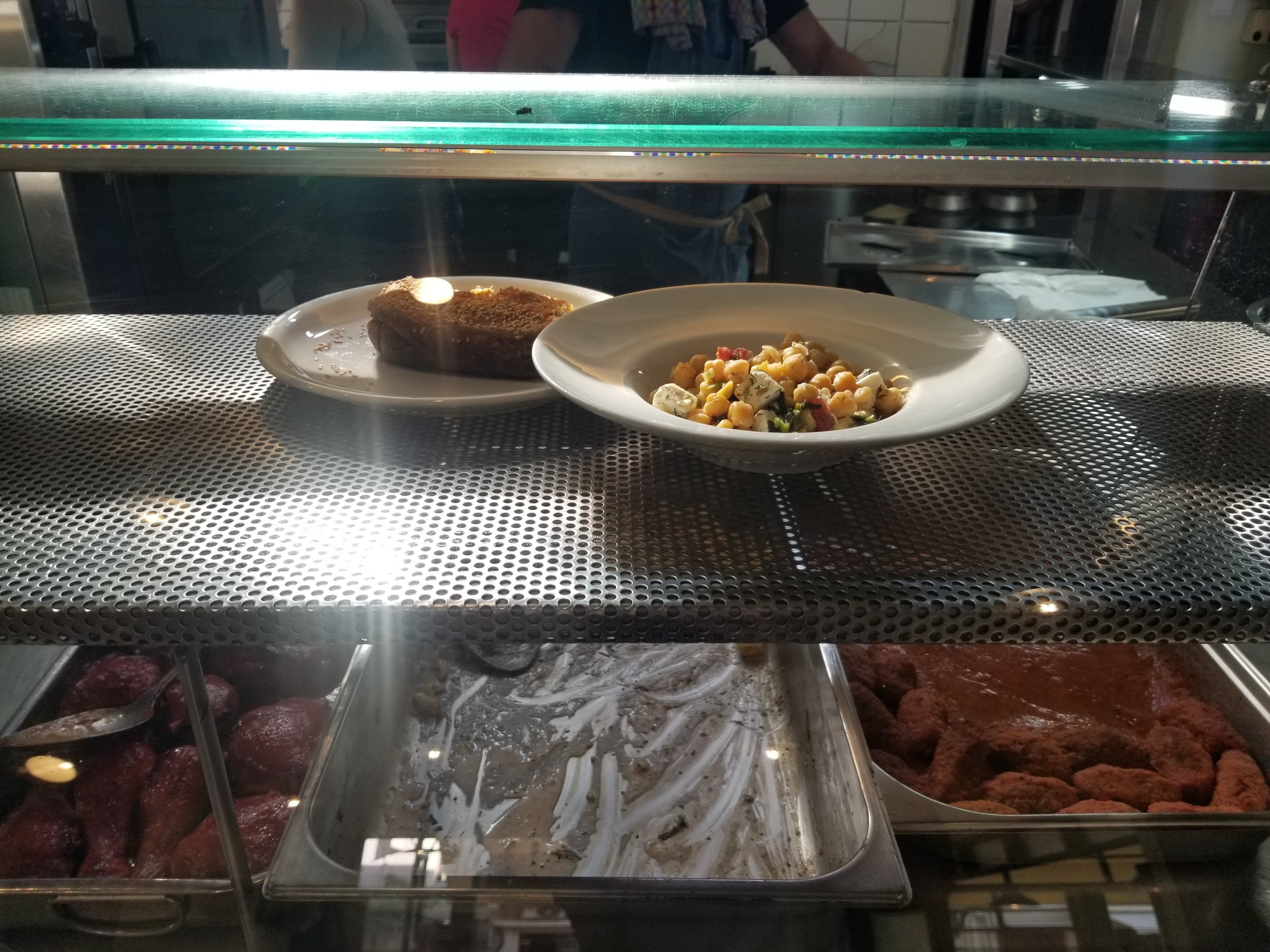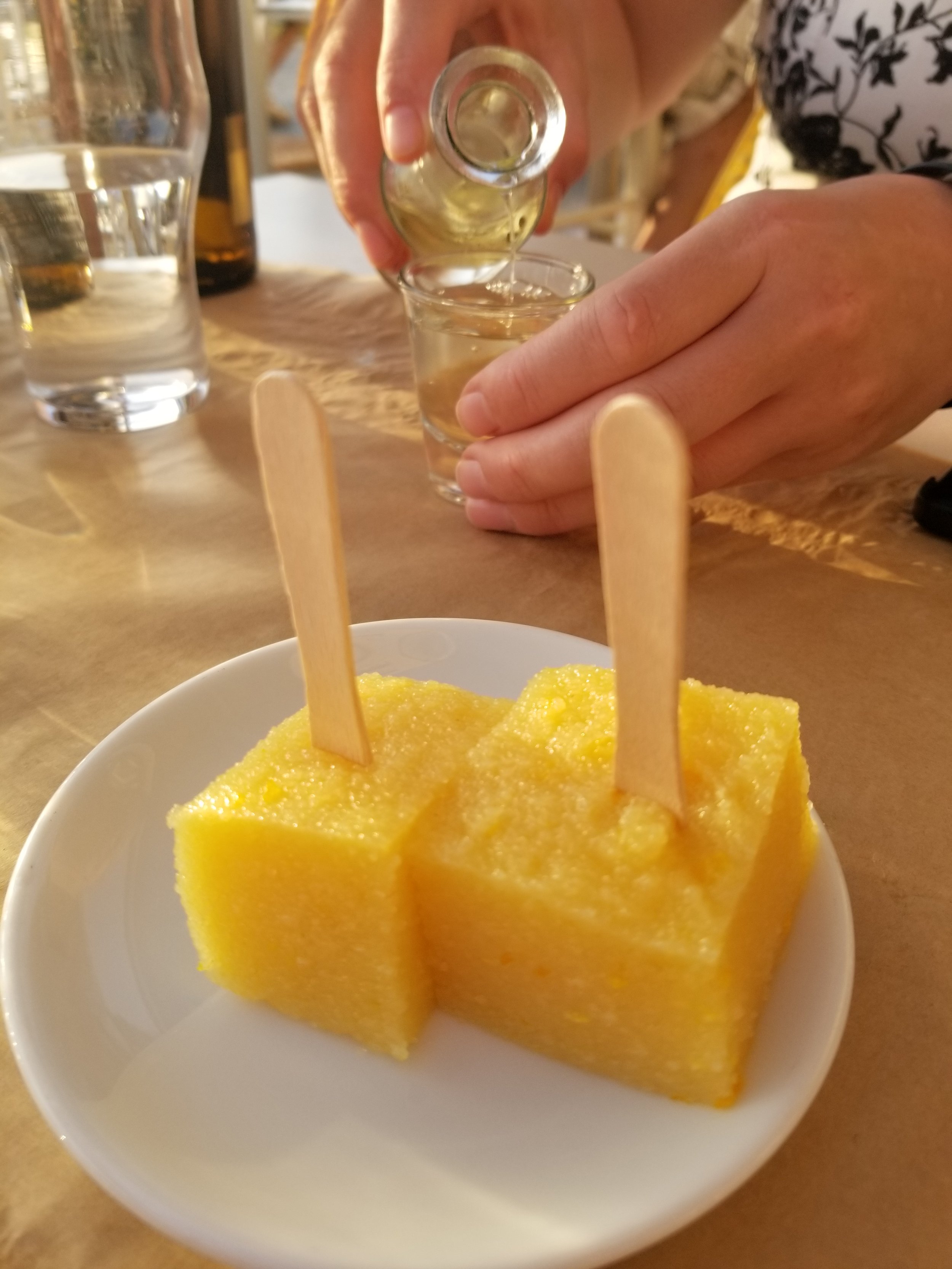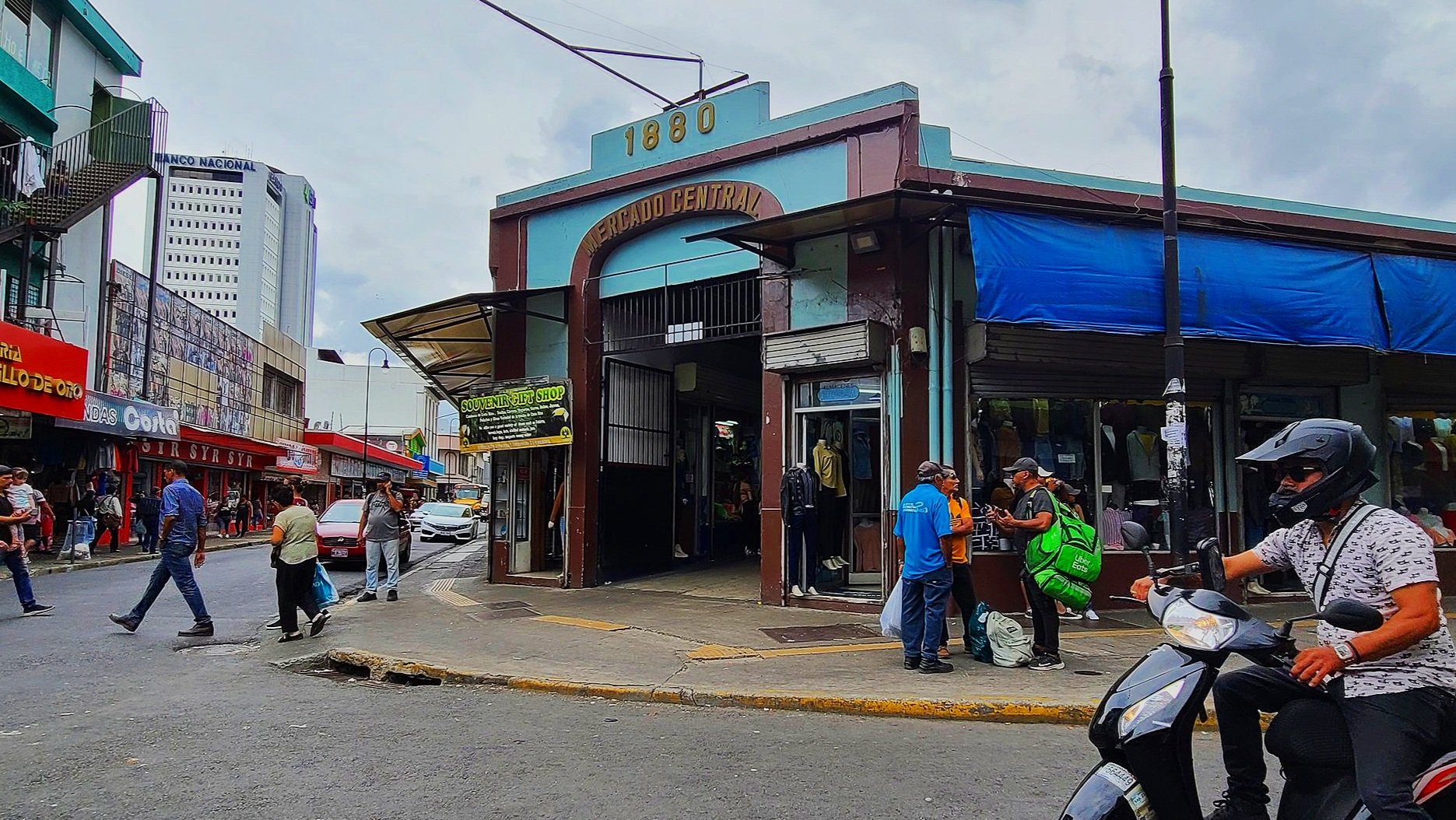I absolutely love Greek food. For 6 years, I lived near Ditmars Boulevard and Steinway Street in Astoria, Queens, a major Greek neighborhood of New York City. In that neighborhood are many traditional Greek restaurants, serving up delicious fresh seafood and souvlaki. Outside of my graduate school in Manhattan, there was a Mediterranean-style food truck that I would often go to for my lunch break—tzatziki sauce, anyone?
I fell in love with this cuisine back then and I was so excited to finally experience it while visiting the country where it came from. The food was absolutely a top reason why I chose Greece as my destination this past summer.
Crete has its own special Greek foods as well as the traditional styles found all over the country. From homemade Mediterranean breakfast spreads to the dish of the day at local tavernas, Crete was an amazing food experience all around.
Cretan Grocery Store Experience
My first day in Crete, one of the first things we did was go to a local grocery store. We went to a SYN.KA Supermarket. We drove to find this larger, more local style store outside of Chania’s main tourist area. The best way for me, especially as a foodie, to get to know a new culture is to visit a store just like this one!
I was hit with a new experience before I even got to the food in this store. SYN.KA has 360-degree-spin shopping carts! Apparently this is common in other European countries, too, because Carolina (from Sweden) was like, “Uhhh, yeeahhh??? What’s the big deal?”
I cannot even begin to tell you what a pleasure it was seamlessly navigating down the aisles and around people. Why this simple piece of novel human ingenuity has not been adopted in the US?—I don’t know.
Anyway, let’s get to the food! There was so much in this store that I could write about, especially because it was not just isolated to Greece but many European imported foods as well. I’ll just highlight a few.
Candy. This is the must-explore category of food for every country for me. SYN.KA had a lovely little end cap with bins from which we could grab and try different types of candy.
The fun part about this is that you don’t really know what you’re going to get. Like one of these candies had a lobster on it. Would it taste like seafood? Only one way to find out (it didn’t!).
Were these assorted hard candies any good? Not my favorite. There were a few choice pieces that I liked—such as some of the softer, taffy-like pieces. But most were a little too bland or unusual for me!
Yogurt. The Greek yogurt options here were in wild abundance compared to in the US.
The US tends to have a pretty diverse yogurt section but the Greek options are typically limited to Fage (responsible for the Greek yogurt craze that started in the USA in the 90s), Oikos (by Dannon, a US company), and Chobani (also a US company). The difference here was the incredible variety of Greek yogurts and the emphasis on varying levels of % fat.
Carolina insisted on getting yogurt that was at least 8% fat or it would “have no taste.” This is apparently common in Europe. In the US, people are concerned about too much fat in their diet while Europeans welcome good fat, like that found in dairy.
I have to admit, the difference was clear in the taste.
Olives. Olives, olives, and more olives. You want olives from the deli? Olives in cans? Olives in jars? Olives in buckets? Olives in sealed packaging? Dried olives? Wet Olives? Olive spread? Olive oil?
This is olive country, after all, so what did you expect?
The olives in sealed plastic, vacuumed packaging is supposedly the traditional way that locals snack on their olives. We got them in that style and in other forms because—when in Greece? Olives.
Fun facts: There are over 1.5 million olive trees in Crete. Cretans pour olive oil onto everything and almost exclusively cook with olive oil. While in the US, consumption of olive oil is about 0.5 liters per person each year, in Crete it’s about 25 liters per person each year.
Cheese. Greeks are known for their feta cheese, of course, but Crete is specifically known for their soft cheese especially made from goats and sheep. Much to my dietary delight, there aren’t any cows on Crete. Anything made from a cow is typically imported.
Cretan cheeses may include Anthotiros (a mild and soft sheep and goat cheese), Graviera (classic hard, rich, buttery cheese), Kefalotiri (usually sheep’s’ milk and is salty, strong and fatty), and Mizithr (typical Cretan milk and whey cheese from sheep and/or goats). One restaurant served Mizithr instead of feta on a Greek salad at the end of a my hike in Samaria Gorge.
Mediterranean Breakfast Spreads
By the time we finished our grocery run, we had enough food to make breakfasts in our Airbnb for every morning of the trip.
Carolina is technically the one who started the meze spread trend. Since she arrived a day before me, she did a little mini-mart shopping and had some leftovers to share. My first morning in Chania, I woke up to her surprising me with a spread of food. It was so good we decided we had to do this for the rest of our time there.
So we bought and always had a spread of the following variety of foods each morning:
Crackers
Paximathia (traditional hard Greek bread)
Pita
Soft goat cheeses
Feta cheese
Yogurt
Olives
Fresh fruits and vegetables
Eggs
Bacon
Smoked salmon
Local honey
Olive oil
Fun facts: Cretans eat more fruit and vegetables than any other group in Western civilization. I also really enjoyed how tasty and fresh the tomatoes were in Crete. Cretan tomatoes have a ton of antioxidant properties, more than in the US because they are all ripened naturally without the use of any hormones.
Eating these beautiful, fresh, and tasty spreads on our balcony while listening to the sounds of Chania in the morning—mwah! This was perfection.
Chania Tavernas (Restaurants)
Typically, I had energy for the whole day from just our breakfasts. At night, we would visit Chania’s restaurants for dinner. Restaurants in Crete are called tavernas. One of the best parts about tavernas on Crete is that their main dishes usually only cost between 5 and 15 euros—such a deal!
There are many, mannnyyyy good tavernas to choose from. We ended up going with recommendations from local Greeks, other travelers, and based on the menus we spotted around our Airbnb.
Oinomaγeipeion
This hole-in-the-wall taverna along Kondilaki street was the first restaurant we went to in Chania. It doesn’t even appear on Google Maps so you’ll have to look for its long Greek name or use the following photo to spot it.
It was one of the few still open at 11pm after getting back from the airport late on a Tuesday.
To keep with tradition, I went with a simple Greek salad. We were served bread. I drank red wine and Carolina had a local beer. Then, bam! I was surprised to find their salad served with not just feta cheese but an entire square chunk of feta right on top with an olive oil drizzle.
This is the typical way feta on salad is served in Greece—and I love it! Doesn’t it look so fresh and amazing?
Tamam
We were lucky to have our Airbnb just 100 feet or so away from the highly recommended taverna, Tamam. Other travelers told me that I must go to this spot. We made it our priority on our first full day together in Crete.
We had such a good experience, we said we would go back but ended up never making it since we found so many other great places.
What we ate:
Bread with olive spread
Grilled Cretan Sausage - A vinegar, pork sausage with cumin and other spices
Domatokeftethes - Tomato fritters served as a crispy appetizer including tomatoes, zucchini, onion, parsley and other herbs.
Grilled squid special with salad and mashed potatoes
Boureki - Cretan pie with zucchini, potatoes, and mizithra (goat cheese)
Glossitses
When we went diving, one of the dive instructors suggested that we go to at least one of two tavernas: Patrelantonis or Glossitses. Patrelantonis was on the southeastern side of the Akrotiri peninsula—a bit too far from where we otherwise were zipping around.
Glossitses, on the other hand, was within walking distance of our Airbnb in the Chania harbor. So we went!
Glossitses is the only taverna we went to twice in Crete. The reason? Their mussels.
Their mussels in white wine were hands down the best mussels I have had in my lifetime. Yes, in my lifetime! And paired with their white wine from Narousa—guh! I was living!
We ordered extra pita just to soak up all the sauce at the end—that sauce was MIRACULOUS!
We proceeded to try mussels in at least 3 other restaurants in Greece, Sweden, and Norway thereafter and, to me, nothing compared.
Here’s all that we ate through our 2 times there (the mussels appetizer being the main focus of our return):
Mussels - 1/2 kg of super large mussels served oh-so-fresh in white wine (or beer) with garlic and herbs
Cuttlefish Pilafi - cuttlefish in its own ink with an olive-oil based rice pilaf
Lamb - local lamb that Carolina substituted fries for salad greens
Tszaziki - traditional Greek yogurt sauce that we dipped with handmade pita bread
Moschato Hambourg - white wine from Naousa
Mesostrato
One night after a very long day, we ordered takeout from the restaurant next door to our Airbnb.
I ordered souvlaki. This is not specific to Crete but it is traditional Greek food—and it was excellent! The chicken souvlaki was served with thinly diced and roasted potatoes, roasted peppers, pita, and a delightful tzatziki sauce.
I ate it on our balcony with a watermelon cider and it-was-blisssss!
Taberna Ela
When Carolina got to Chania, she first spotted a restaurant down the street from our Airbnb advertising a seafood meze (meaning “taste” or “bite”) board for 2 for 50 euros! We made a plan to check it out one night when we felt like being super gluttonous and full. That night was on night 6 of our trip.
This board included 7 different types of seafood, such as cuttlefish, shrimp, bream, calamari, octopus, and more.
Before
After
Kouzina EPE
On our last day in Chania, we went to an early dinner at a taverna that is a local favorite. There is a standing menu of traditional cuisine but the highlight is the daily menu or “dishes of the day” at this location. You absolutely should order from the daily menu, as it offers unique, fresh dishes that you won’t want to miss.
Our mistake was arriving at 5pm. This is more of a lunch spot keeping hours from Noon to 7:30pm. Alas, we still caught a bit of the experience and I would highly recommend going if you’re looking for something unique.
To be honest, I’m not entirely sure what we ate for at least some of the items. These were dishes that were available at the end of the day and we basically just pointed at the display of examples they had, asked what it was, and said “one of those, please” and one of those and one of those, etc.
What (I think) we ate:
Vegetarian stuffed sunflowers (amazing!) - kind of like stuffed grape leaves which I am a big fan of
Spinach and cheese pie (loved this - was better than Tamam’s pie)
Slow roasted pork stew
Fish dish (not my favorite)
Beef dish (Carolina loved it)
Because we were late, we did not get to try their famous panna cotta dessert. People absolutely rave about this dessert! Instead, we had a yogurt with candied fruit slices which was also amazing.
Free Shots and Desserts
Speaking of dessert, I completely skipped talking about it for each taverna because of how special dessert is in Greece. It’s so special that you never pay for it. As in, they just give you a little something at the end of every meal.
They usually serve the dessert with shots of Cretan Raki. Raki or tsikoudia is a pomace brandy made from twice-distilled grapes. It kind of tastes like a strong vodka or saki. Most visitors say they don’t like it. I enjoyed it! Many people prefer flavored Raki but it’s rare. I believe we only had a flavored Raki at one location (and it was good).
Raki is a big part of Greek hospitality. It’s meant to signal friendship and nobility. I wanted to know how to say “cheers” in Greek. The server told me it’s “Yiamas!” (yAH-mos).
Watch below as I take my first shot of Raki at Yamam.
The reason I separated this Greek taverna tradition is that I don’t really know what many of the desserts were! They usually delivered them and then the server disappeared. If we did ask, often they didn’t know how to describe it in English. Or, quite frankly, I’ve forgotten what they told us by now. Regardless, we would nom whatever it was down, usually really enjoying it!
The following photos show a few examples of desserts and raki we were served at the end of many meals in Crete.
Grainy cake served at Tamam
Fruity cake pieces served at Glossitses
Ice cream served at Taberna Ela
Other types of traditional pastry-like desserts we ate were from a bakery while we waited for laundry one afternoon. This included Kalitsounia, a sweet cheese pie usually served on Easter, and Sarikopitaki, another type of pie that is sheep-cheese-filled and usually served with honey on top.
Missed Tastes
Other dishes that are traditional to Crete that I did not try are:
Dakos - like a bruschetta this is finely chopped tomato, cheese, herbs and olive oil on a Paximadi
Fried Snails - exactly how they sound usually served with butter and herbs. I owned a pet snail once so this will always be a no for me! ;)
In Conclusion
All of the food I ate in Crete was absolutely amazing. Well, except one place that I didn’t mention where they ran out of pizza and served us the saddest, most tasteless cobb salad I’ve ever had! But other than that, I really enjoyed my time exploring the Cretan cuisine.
Between the two of us, Carolina and I managed to hit almost all the famous Creten cuisine. But there was still more to taste—especially on the next island we visited! You’ll have to wait a few weeks for my coverage of Santorini to read about the food there!


















